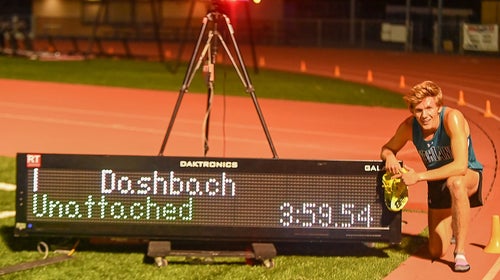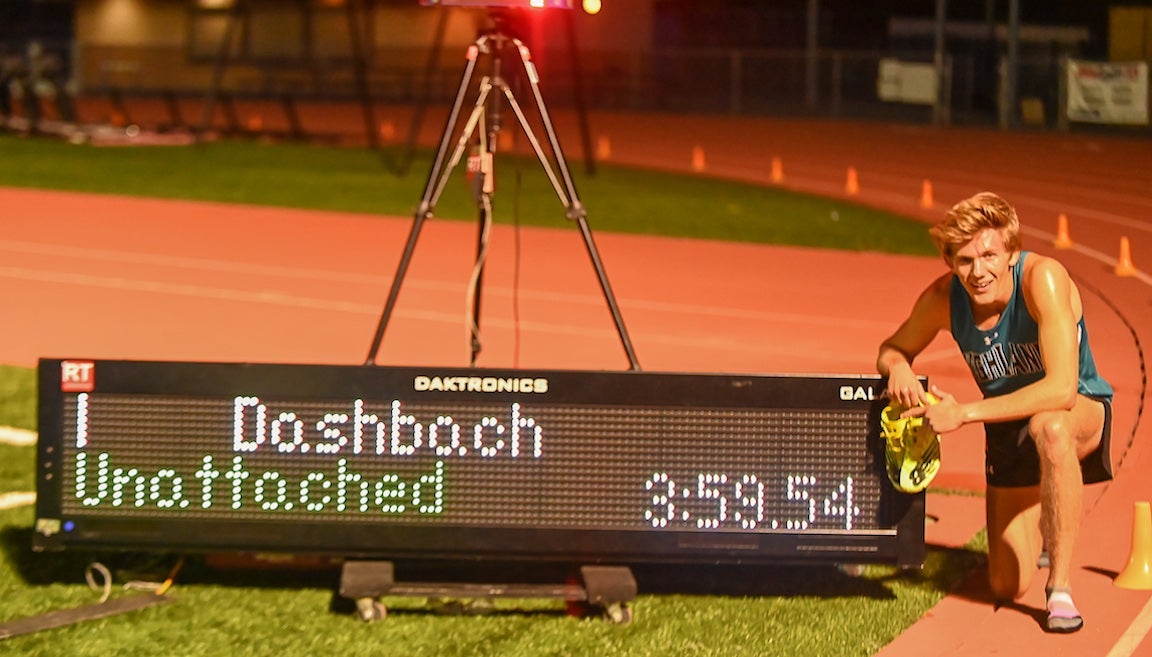Everyone is searching for silver linings these days, and perhaps none more so than high school and college seniors, whose traditional springtime rites of passage have been upended during the coronavirus pandemic.
Facing a canceled outdoor track season, Highland High School senior Leo Daschbach of Gilbert, Ariz., channeled the frustration of quarantine into his training and ended up in the history books last weekend by becoming the 11th high school boy to break four minutes in the mile. His official time of 3:59.54 makes him the ninth-fastest high schooler in U.S. history.
“At first, I was sad,” Daschbach said of his canceled senior spring. “But then I talked to my coach and was like, ‘we’ve just got to change the mentality.’ I want to keep working hard and shoot for this goal.”
Shifting Focus to the Clock

Photo: Daniel Tyree
The sub-four minute mile has long been considered the gold standard for prep boys’ running. Before Alan Webb dismantled Jim Ryun’s national high school record in 3:53.43 in 2001, only three boys had ever conquered the barrier. Lukas Verzbicas added his name to the list in 2011, and since 2015, the sub-four stream has been steady as six boys joined the club and dozens more have come extremely close.
For Daschbach, the dream became a possibility last year when he ran 4:03.98 for the mile and 14:14.26 for 5K during the cross country season in Arizona.
“I knew that I had the ability, or the potential to do it,” he told PodiumRunner.
But before the coronavirus pandemic canceled school and sporting events across the United States for the duration of the spring, running a sub-four minute mile wasn’t actually his goal.
“I was more focused on racing and competing,” he says.
The original plan for Daschbach’s senior year was to spend the first half of the outdoor track season focusing on the 3200m in preparation for the elite race at the Arcadia Invitational in California, where he ran 8:51.09 last year. After Arcadia, he and his coach were going to adjust workouts to sharpen up for end-of-season mile races.
“Once everything got canceled, the whole mentality switched because [chasing a time] is really the only thing we could do,” he says.
Daschbach completed all of his training on his own, in accordance with Arizona’s shelter-in-place orders. A typical week this spring included 50 to 55 miles of running with two hard workouts and three makeshift home weight-lifting days, plus daily core and yoga routines.
Leo Daschbach’s typical week of training
Monday: “Spike up” for hard interval track workout + lift
Tuesday: Easy run
Wednesday: Easy run
Thursday: Hard workout + lift
Friday: Easy run + lift
Saturday: Long run with hard close (example: 12 mile long run with 7-8 miles easy, finish at 5:10-5:20 pace)
Sunday: Off day or 2-3 mile shakeout
Total mileage: 50-55 mpw
Key workouts:
9 days pre-race: 6 x 400m @ 56 seconds (average) with 500m jog recovery
5 days pre-race: 800m/600m/400m/300m/200m @ 2:02/1:29/54/40/27 with 5:00/4:00/3:00/2:30 rest
3 days pre-race: 8 x 200m @ faster than mile pace (average 27 seconds with the last 3 @ 26/25 high) with 100m walk rest
Week of the race: 3 x 200m strides @ 27 seconds after every easy run
Daschbach still had access to a track and consulted with his high school coach, David Montgomery, for workouts and a training plan, which was anchored by three time trials: a paced 4:03 mile in mid-April, a 1:49.9 personal best 800m a few weeks later, and a solo 4:07 mile.
The Race
By May, a group of elite high school runners from around the country were talking about setting up an official sub-four attempt. Organizer Matt Strangio of California, who clocked a 4:03.57 mile in April, arranged for the event, dubbed “The Quarantine Clasico,” to take place on Saturday, May 23 at Oak Ridge High School in Sacramento, California, complete with a race official, automatic timing system and MileSplit live-stream.
Eight athletes from Arizona, Colorado and Utah traveled to compete in the race, where, under El Dorado County’s COVID-19 Phase 2 reopening guidelines, small groups were by then permitted to gather for recreational purposes as long as all persons maintained six feet of physical distance from each other.
Daschbach flew on an airplane to get to the Sacramento area, but wasn’t worried about the increased risks of traveling.
“I think we were mostly excited and hungry to get a race in,” he said of his family and coach’s reaction to the race opportunity.
By race day, Strangio had dropped out due to injury, leaving Daschbach as the presumptive favorite to break four.
“I was really nervous,” he says. “I felt like there was a lot of external pressure on me from everyone everywhere since this was the one high school race. Because of the times I’d put up this year [in time trials], people were largely saying I was supposed to be the one to do it… I also felt like I was a source of inspiration for people, so that if I failed, I would be letting all these people down. I really didn’t want that to happen.”
In addition to the external pressure, he wasn’t feeling great about his most recent time trial, the 4:07 mile, when he says “the lack of competition and abundance of hard workouts started to weigh on me.”

Photo: Daniel Tyree
On race day, he woke up early—around 7 a.m.—and tried to stay relaxed. He ate breakfast, watched TV, took a nap, and whiled away the hours until race time. During the warmup, he tried to block out a headache and impending nausea.
Pacers led the field through 2:02 at halfway—too slow—though Daschbach says he wasn’t paying attention to the clock. His race plan was to stick behind the leaders until the bell lap, which he did. But then Stanford signee Thomas Boyden of Utah put in a big final surge. They would need a sub-57 second last lap to break four. Daschbach kept his composure and unleashed his signature kick with 250 meters to go—later than he wanted, but effective nonetheless. He closed in an astounding 56.81 to sneak under four minutes.
“It was a lot of fun getting to race again,” he says. “I didn’t focus on the time [during the race], I just focused on my strategy and sticking to the plan, just doing my best to get to the end of the line the best way I know how to do it.”

What’s Next?
Next up for the future Washington Husky is a few weeks of downtime before ramping up the summer mileage to prepare for his first collegiate cross country season.
The spring has certainly been a season to remember.
“You just have to adapt to hard situations,” he says. “It really sucks and I’m sad to know that all those races, competitions are gone, but I can’t complain that much, I still managed to do something great with my season so I’m not all that bummed.”
It’s possible that without the extreme limitations set in place by the pandemic, Daschbach would never have touched sub-four this spring—though he is understandably loath to chalk up his success to the coronavirus.
“The training would have been a little bit lower in quality because of all the racing I would have been doing [during a regular season],” he says. “I did three time trials and everything else was just grinding and hard workouts, so it probably paid off in a sense… I can’t say if I would have [broken four in a regular season] or not, but I would have had to do it sometime into June if we had done two-mile training.
“If anything, [the pandemic] just meant that I could do it earlier.”


